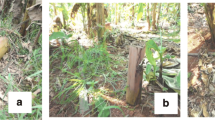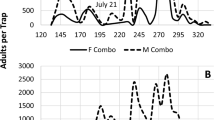Abstract
Response of adults of the West Indian sugarcane weevil,Metamasius hemipterus sericeus, to various semiochemical treatments and physical trap designs was studied in southern Florida in field-grown banana and Canary Island date palms. Ethyl acetate released alone at 860–1007 mg/day was as effective for the capture ofM. h. sericeus as a combination of ethyl acetate (844–919 mg/day), ethyl propionate (348–362 mg/day), and ethyl butyrate (117–137 mg/day) and in one trial was more effective than fermenting sugarcane (250 g), ethyl propionate alone (353–384 mg/day), ethyl butyrate alone (123–174 mg/day), or no treatment. Ethyl acetate released alone at 675–683 mg/day was as attractive as 250 g of fermenting sugarcane or the racemic blend of the male-produced aggregation pheromones [(±)-5-methyl-nonan-4-ol and (±)-2-methyl-heptan-4-ol (8:1 ratio) “metalure”] at 3 mg/day. Weevil counts increased with binary combinations of ethyl acetate, sugarcane, and/or metalure over these treatments alone and the ternary combination was two to three times more effective than any of the binary treatments. Attraction to ethyl acetate released alone at 777 mg/day with metalure was greater than to the hydrolysis products of ethyl acetate (ethanol and/or acetic acid each released at about 6–8 mg/day) with metalure. Weevil counts from traps baited with 250 g of sugarcane and metalure increased with increasing dose of ethyl acetate to about 400 mg/day and then appeared to plateau. Ethyl acetate (about 700 mg/day) and metalure increased weevil counts in traps with increasing amounts of sugarcane (0–2 kg). Molasses (45 g) + water (158 ml) substitutes for sugarcane were about as effective for capturingM. h. sericeus as 250 g of fermenting sugarcane [all treatments with ethyl acetate (847 mg/day) and metalure]. Early experiments used a lethal pitfall trap. We demonstrated that several alternative trap designs were more effective than the lethal pitfall trap for capturing weevils. Color and height (on ground vs. 1 m on pole) did not affect trap efficacy when baited with the ternary combination of ethyl acetate (672–825 mg/day), sugarcane (250 g), and metalure.
Similar content being viewed by others
References
Arango, S. G., andRizo, D. 1977. Algunas consideraciones sobre el comportamiento deRhynchophorus palmarum y Metamasius hemipterus en caña de azucar.Rev. Colomb. Entomol. 3:23–28.
Giblin-Davis, R. M., Weissling, T. J., Oehlschlager, A. C., andGonzalez, L. M. 1994a. Field response ofRhynchophorus cruentatus (Coleoptera: Curculionidae) to its aggregation pheromone and fermenting plant volatiles.Fl. Entomol. 77:164–177.
Giblin-Davis, R. M., Peña, J. E., andDuncan, R. E. 1994b. Lethal pitfall trap for evaluation of semiochemical-mediated attraction ofMetamasius hemipterus sericeus (Coleoptera: Curculionidae).Fl. Entomol. 77:247–255.
Gries, G., Gries, R., Perez, A. L., Gonzales, L. M., Pierce, H. D., Jr., Oehlschlager, A. C., Rhainds, M., Zebeyou, M., andKouame, B. 1994. Ethyl propionate: Synergistic kairomone for African palm weevil,Rhynchophorus phoenicis L. (Coleoptera: Curculionidae).J. Chem. Ecol. 20:889–897.
Jaffé, K., Sanchez, P., Cerda, H., Hernandez, J. V., Jaffé, R., Undandta, N., Guerra, G., Martinez, R., andMiras, B. 1993. Chemical ecology of the palm weevilRhynchophorus palmarum (L.) (Coleoptera: Curculionidae): Attraction to host plants and to a male-produced aggregation pheromone.J. Chem. Ecol. 19:1703–1720.
Oehlschlager, A. C., Chinchilla, C. M., Gonzalez, Jiron, L. F., Mexzon, R., andMorgan, B. 1993. Development of a pheromone-based trapping system forRhynchophorus palmarum (Coleoptera: Curculionidae).J. Econ. Entomol. 86:1381–1392.
Rochat, D. C., Malosse, C., Lettere, M., Ramirez-Lucas, P., Eihhorn, J., andZagatti, P. 1993. Identification of new pheromone-related compounds from volatiles produced by males of four Rhynchophorinae weevils.C.R. Acad. Sci. Paris Ser. II. 316:1737–1742.
Samarajeewa, U., Adams, M. R., andRobinson, J. M. 1981. Major volatiles in Sri Lankan arrack, a palm wine distillate.J. Food Technol. 16:437–444.
SASInstitute. 1985. SAS User's Guide: Statistics, 5th ed. SAS Institute, Cary, North Carolina.
Vaurie, P. 1966. A revision of the Neotropical genusMetamasius (Coleoptera, Curculionidae, Rhynchophorinae). Species groups I and II.Bull. Am. Mus. Nat. Hist. 131:213–337.
Woodruff, R. E., andBaranowski, R. M. 1985.Metamasius hemipterus (Linnaeus) recently established in Florida (Coleoptera: Curculionidae). Florida Department of Agric. and Consumer Services Division of Plant Industry, Entomology Circular No. 272, 4 pp.
Author information
Authors and Affiliations
Rights and permissions
About this article
Cite this article
Giblin-Davis, R.M., Peña, J.E., Oehlschlager, A.C. et al. Optimization of semiochemical-based trapping ofMetamasius hemipterus sericeus (Olivier) (Coleoptera: Curculionidae). J Chem Ecol 22, 1389–1410 (1996). https://doi.org/10.1007/BF02027720
Received:
Accepted:
Issue Date:
DOI: https://doi.org/10.1007/BF02027720




